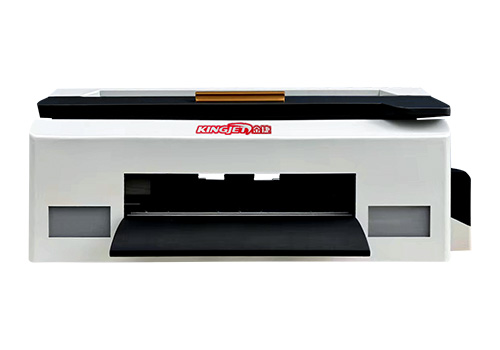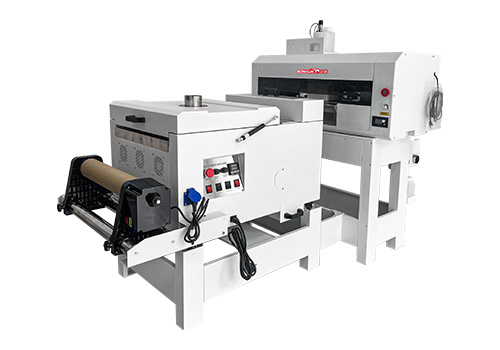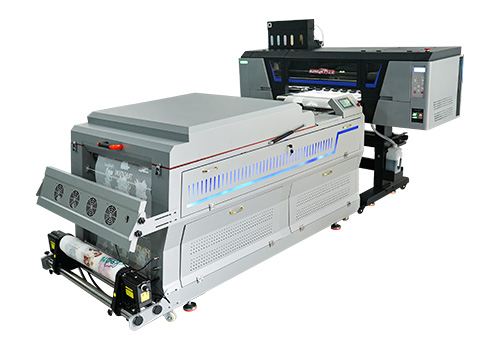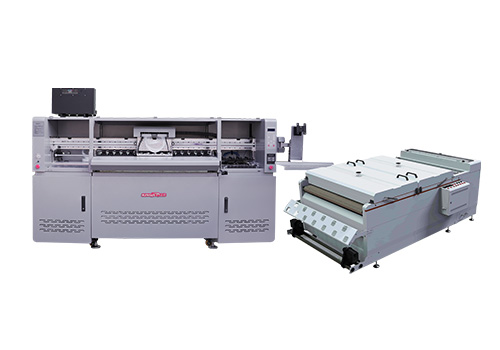6 Expert Guides to Choose the Right DTF Printer
2024-05-17
With the continuous development and progress of digital printing technology, DTF (Direct-to-Film) printing technology has become an important production tool in the textile and clothing industries. More and more enterprises also favor DTF printers due to their advantages such as fast printing speed, vivid colors, and environmental friendliness.
However, with various types and different performances of DTF printers on the market, choosing the right DTF printer that meets your business needs and has high cost-effectiveness has become a focus for many enterprises. This article will detail the following 6 aspects of selecting a suitable DTF printer for your printing business needs.
Table of Contents
Understanding the Basic Principles and Technology of DTF Printers
DTF (Direct-to-Film) printers are a new type of digital inkjet printing technology, mainly used in the clothing industry, which can achieve high-quality printing on various materials, including T-shirts, hoodies, jeans, hats, canvas, and other fabrics.
The design pattern is first printed directly onto a special PET film, followed by uniform powder spreading, high-temperature drying, and color fixing, and finally, the pattern is pressed onto the clothing through a heat press machine. This printing method does not require plate making, engraving, or waste discharge, and there is no minimum order quantity limit. To learn more about DTF printer knowledge, you can refer to another article “What is DTF Printer?”.
Analyzing Market Conditions and Clarifying Printing Business Needs
Before selecting a suitable DTF printer, it is essential to analyze the market conditions in your region and clarify your printing business needs and user requirements. Consider the fabrics you may process and the business volume, as different materials can affect the quality and durability of printed products, while different sizes of printers can also impact production efficiency. Narrow down your selection by understanding the printing materials and printer width.
Printing Materials: Cotton fabrics are soft and comfortable to the touch; polyester fibers have better wrinkle resistance and are less prone to shrinkage and deformation; nylon fabrics have better elasticity and abrasion resistance; leather fabrics have a smooth surface, making printing more challenging.
Printing Width: Printing width refers to the maximum size that a DTF printer can print. Choose an appropriate printing width based on product size and market demand. An overly large printing width can increase equipment costs and occupy space, while an overly small printing width may not meet production needs.
Common printing sizes on the market include A3, 12-inch, 24-inch, 80cm, and 1.2m. Small A3 and 12-inch DTF printers can meet daily production and high-quality printing for T-shirts and hoodies, etc.; large-format and high-performance 24-inch and 80cm DTF printers support customized and large-volume production, while super-large-format, professional, and industrial-grade 1.2m DTF printers are more suitable for batch and efficient production in large clothing factories.
Understanding DTF Printer Performance Indicators
When selecting a suitable DTF printer, pay attention to the following performance indicators:
Printhead Technology: The printhead is a core component of a DTF printer. Different printhead technologies have different printing accuracy, speed, and stability. Currently, popular printheads include EPSON XP600, I1600, and I3200. If you have specific requirements for the machine and need high-precision, high-quality printing, EPSON I3200 is the preferred choice. If you are not too demanding on the machine and consider cost-effectiveness, EPSON XP600 is a good option. Therefore, it is crucial to choose a suitable printhead based on your actual printing needs.
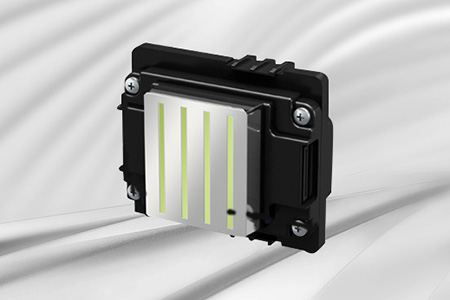
Resolution: Resolution is an important indicator that measures the printing quality of DTF printers, determining the clarity of printed images. Generally speaking, the higher the resolution, the clearer the printed image. However, it is important to note that excessively high resolution can increase the cost of the printer, so it is necessary to select an appropriate resolution based on your economic needs.
Printing Speed: Printing speed is an essential parameter that measures the performance of DTF printers. Faster printing speed means higher production efficiency, which can better meet the demand for large-volume printing. However, it is also necessary to pursue printing speed while ensuring print quality.
Ink System: The ink system directly affects printing quality and cost. Equipped with a white ink circulation and stirring system, it can ensure smooth ink flow, prevent nozzle clogging, and produce high-quality designs. Therefore, choosing an environmentally friendly, stable, and cost-effective ink system is crucial.
Comparing Prices and After-sales Warranty Services
Before selecting a suitable DTF printer, you can visit the official websites of relevant DTF printer manufacturers, contact local agents, or attend industry exhibitions to understand the performance, specifications, prices, and other information of different brands of DTF printers.
Besides considering the price, you also need to consider the product quality, stability, and after-sales warranty services. You can learn about the product quality and the manufacturer’s after-sales warranty services by checking user reviews and industry reputation. After comparison, you will be able to find a cost-effective product with low maintenance requirements, as well as a manufacturer that provides thoughtful and prompt after-sales support.
Considering the Scalability and Compatibility of DTF Printers
When selecting a DTF printer, you also need to consider its scalability and compatibility.
Scalability: As your business grows, you may need to add more printing equipment or upgrade your current equipment. Choosing a scalable DTF printer will facilitate future upgrades and expansions. For example, some DTF printers support adding multiple print heads and expanding the printing area.
Compatibility: Different DTF printers may support different design software, file formats, etc. Choosing a DTF printer with good compatibility will make it easier for you to integrate with your existing design software and file formats. For instance, some DTF printers support various RIP software such as Maintop, Photoprint, CADlink, and more.
Checking User Reviews and Feedback
Before purchasing a suitable DTF (Direct-to-Film) printer, reviewing other users’ satisfaction, usage, and actual experience with the DTF printer will help you gain a deeper understanding of the product’s actual performance, quality, advantages, and disadvantages. This will enable you to identify which printers are worth purchasing or considering, and which ones are not suitable for you or do not meet your printing needs, making a more rational purchase decision.
Conclusion
Selecting a DTF printer that suits your printing business needs involves considering multiple factors. Here are some guiding suggestions:
Clarify your needs: Determine the printing materials and the size of the machine you need based on your business requirements.
Understand technical specifications: These include printing accuracy, resolution, nozzle type, ink system, etc., which directly affect print quality and efficiency.
Consider cost-effectiveness: When selecting a DTF printer, consider not only the equipment price but also its operating costs, consumable costs, and maintenance costs. Choosing a cost-effective device can bring more profits to your business.
Consider reliability and stability: DTF printers are long-term equipment. Choosing a brand and model that has been market-tested and has a good reputation can ensure the stability and reliability of the equipment.
Consider after-sales service: Choosing a manufacturer or agent that provides comprehensive after-sales service can ensure timely technical support and maintenance services during use. This will help resolve equipment failures and ensure smooth production.
Conduct on-site inspections and trials: If conditions permit, it is recommended that you conduct on-site inspections of the manufacturer or agent’s production environment, equipment quality, and service level. At the same time, you can also request a trial of the equipment to better understand its performance and ease of operation.
Pay attention to technological trends: As technology continues to develop, DTF printers are also constantly upgrading and improving. When selecting equipment, you can keep an eye on new technologies and features to choose more advanced and efficient equipment.
Choosing a DTF printer that suits your printing business needs is a complex and important decision-making process. Hopefully, the in-depth analysis and practical guidelines provided in this article can help you make a wise choice. No matter which printer you choose, remember that a high-quality printer and the help of a professional team will bring you the greatest value.
If you need assistance selecting the ideal DTF printer, our skilled and experienced team will provide you with professional purchasing advice. please get in touch with the professional KingJet team now.
FAQ
DTF printing process?
Print the designed pattern on the PET film, then evenly sprinkle hot melt powder on the pattern, melt it at high temperature and then dry it, cut the PET film pattern, and heat-press the pattern onto various types of clothing through heat press, and then you can complete the clothing printing.
What fabrics can DTF technology be applied to?
Any fabric which can stand 170℃ heat press temperature can be transferred by DTF, like cotton, T-shirts, jeans, canvas, sweatshirts, polyester, etc.
How long will the print last on the garment? How many times will it be washed?
Under normal wear and standard washing operations, DTF print can usually withstand approximately 50 to 100 washing cycles in accordance with the international washing standard.
What is the print cost for DTF?
Print cost for 1 sqm transfer fabric pattern is about 1-2 usd, and about 0.07-0.1usd for A4 size Printing.

